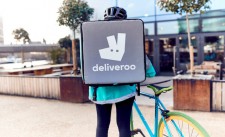U.K. Has Been Taken Over by Takeaway, Now Another Culture That Prompts Restaurants to Prop Up There Packaging Quality and Branding Style

LITTLE HOUGHTON, U.K., September 15, 2017 (Newswire.com) - Home Delivery Services have increased demand for quality cuisine from dine-in restaurants. Each day a restaurant is serving more customers today, than it can accommodate within its sitting area. High Street Restaurants are reaching U.K. dining rooms without having to extend their space, what else could they want?
All they are doing is spending more on branding their packaging, Leslie Carr of Scyphus, a Director of the Printed Paper Cup Company, writes while holidaying in Rhodes, Greece, that these fine dining restaurants are their new elite customers, people who'd earlier spend money on fine cutlery and porcelain, are now coming to Scyphus for high-quality printed paper cups, boxes and pots and paper bags for home delivery orders. A win-win for all it looks like.
Britons’ appetite for restaurant meals fuels food delivery services
Deeply entrenched dining traditions in the United Kingdom are becoming a thing of the past. More and more Britons are ditching sit-in restaurants and traditional pubs for home delivered gourmet meals. A recent survey conducted by Paymentsense highlighted that 57 percent of Britons prefer to have their takeaway meals delivered. This change in eating habits is propelling the food delivery services- an industry worth £3.6 billion in 2016.
Savouring gourmet meals from the comfort of the home
Millions of Britons are more and more unwilling to leave their home to eat out or party. In the same vein, they are even more reluctant to prepare food at home. This altering of eating behaviour is bolstered by various factors such as saving money, spending less on drinking, and an increased interest in catching up with TV entertainment and subscription channels. Others prefer to stay at home to eat to avoid bumping into people they do not want to meet or to just to avoid using public transport.
A survey carried out by Deliveroo last year concluded that 50 percent of the respondents have ditched friends on the eve of a night out simply to stay at home. Even the 18-24-year-old generation is adopting the stay-at-home trend, with 72 percent stating they do so willingly.
This tendency is subsequently fuelling the consumption of takeaway food and food delivery services likewise. Statistics of 2016 show that the demand for home deliveries boomed 10 times faster than dining out itself. The delivery channel was worth £3.6 billion, that is, 50 percent higher than it was in 2008. It is predicted that the United Kingdom will spend approximately £8 billion by the end of 2026, with households becoming more time-pressed.
Fine dining at home is changing the food industry landscape
Not mastering the art of cooking does not imply that one is depriving himself of good food while staying at home. The food delivery industry has undergone multiple revolutions; starting from the clip-clop of horses associated with the delivering milk in the United Kingdom and extending to pizza home delivery, today’s delivery channels propose an incredible array of gourmet menus that one can relish without setting a foot out. “You don’t need a silver fork to eat good food,” as truly pinpointed the American celebrity chef Paul Prudhomme.
With high-quality takeaway disposable containers available today, restaurants or food outlets have found it easier to cater for the diverse needs and wishes of clients seeking their food to be delivered at their doorstep. Whether it concerns fluid food like noodles or soups, any restaurant menu may be offered for home delivery today.
This trend for home delivery food has given rise to an impressive number of delivery channel services. Brands like Deliveroo, UberEats, Just Eat or Hungry House have reacted promptly to be part of the food revolution. Deliveroo, for instance, has witnessed a growth of 650% in its delivery orders in 2016. The brand noted that clients are no more viewing restaurant dishes as an indulgent weekend treat. On a parallel note, other brands are sprouting to focus solely on the home delivery option. In London, for example, the rotisserie Clockjack has a delivery-only kitchen exclusively for Deliveroo orders. Companies oriented towards food delivery services have already been transformed into a buoyant industry.
Traditional pubs are succumbing to the pressure
Home delivery is becoming a key feature for the success of restaurants and pubs in the United Kingdom. As fewer people visit these places, pubs are having to adapt and innovate in a bid to attract clients. Nonetheless, this task is proving herculean as they have to cope with numerous competitors offering food delivery. It has been noted that even beer is being sold more in supermarkets than in pubs, with Britons preferring to consume their beverage at home together with their takeaway meals.
Pubs have long been part of the British culture and were not only regarded as a place to eat and drink, but as a unique social centre. Many pub groups are being restructured, offering premium food and drinks such as artisan coffee or mini-burgers as well, and embracing the home delivery option as well to stay afloat.
Online ordering is a key driver in takeaway food
The rising number of smartphone users and the growing number of mobile apps available for ordering food are promoting food delivery channels. Today, with a simple touch a client may order and pay for his food through his mobile phone. Companies specialized in food delivery are betting on the busy lifestyle of Britons to attract the latter through easy and convenient ordering systems as an economic alternative for dinner.
Companies like Domino’s Pizza Group Ltd. offers three different means to order food through applications like Facebook Messenger, its mobile app or on its website itself to target the maximum number of clients. With more and more clients ordering online and seeking home delivery, restaurants are partnering with third-party delivery service to ensure customer satisfaction.
There is still room for takeaway lunch and breakfast
If currently the delivery service is largely associated with dinner, there is still room for companies to cater for lunch and breakfast. According to NPD Group, delivery services for breakfast in the United Kingdom actually accounts for 5 percent only while they amount to 11 percent for lunch. The figures are low compared to deliveries for dinner that make up 65 percent. There is clearly a market opportunity for exploiting the gap as it has been noted that Britons are also opting for the on-the-go meals during the day, the lunchtime being dramatically compressed to some 15 minutes on the average.
The large time spent in commuting and at the workplace is equally forcing people in the United Kingdom to eat at various times during the day instead of sticking to traditional eating hours. By offering delivery services for lunch and breakfast, and promoting special meal deals applying only to deliveries, companies and restaurants are bound to hit hard.
Source: Scyphus, UK
